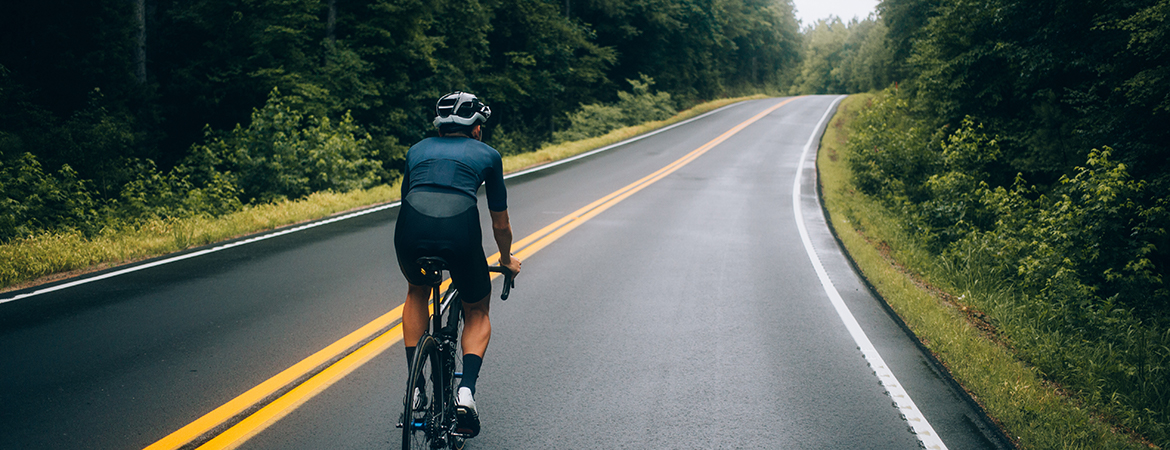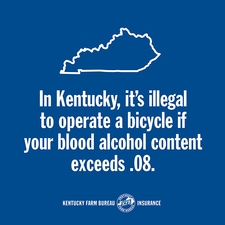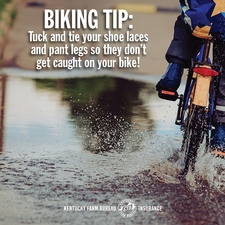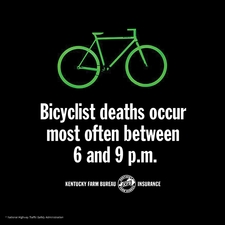14 tips for bicycle safety
When it comes to the motorist-cyclist relationship, remember that it’s a two-way street! A mutual respect between drivers and bicyclists must exist for each type of traveler to arrive at their destination safely.

As warmer temperatures hit the Bluegrass State, more and more Kentuckians will be out enjoying the weather via bicycle. Some may hop on a cruiser for a casual neighborhood pedal, while others might opt for a high-speed road ride to their favorite coffee shop.
Americans are increasingly using bicycling as a true means of transportation – the number of cyclists traveling to and from work has more than doubled in the last decade. By law, bicycles on the roadway have the same rights and responsibilities as motorized vehicles. When it comes to the motorist-cyclist relationship, everyone needs to remember that it’s a two-way street! A mutual respect between drivers and bicyclists must exist for each type of traveler to arrive at their destination safely.
Check out these tips and help make Kentucky’s roadways peaceful for both those behind the wheel and those behind the handle bars:
If you are a bicyclist:
- Do not drink and ride! In Kentucky, it’s actually illegal to operate a bike if your blood alcohol content (BAC) exceeds .08. Under KRS (Kentucky Revised Statute) 189.520, “No person under the influence of intoxicating beverages or any substance which may impair one's driving ability shall operate a vehicle that is not a motor vehicle anywhere in this state.” According to the National Highway Traffic Safety Administration (NHTSA), 21 percent of bicyclists killed in crashes had a BAC of .08 or higher – the illegal limit in most states.
- Get the right bike. One that’s too big or too small will be harder to control. Make sure it’s tuned up and works right (it doesn’t matter how well you ride if the brakes don’t work!).
- Wear equipment that makes you more visible to others, like bright clothes during the day and reflective gear and lights/reflectors at night. According to the NHTSA, bicyclist deaths occur most often between 6 and 9 p.m.
- Ride one per seat, with both hands on the handlebars!
- Be predictable. Learn the proper turn signals and use them consistently. Ride where drivers expect to see you and go with the flow of traffic. Obey all traffic signals and signs as if you were in a car.
- Avoid or minimize sidewalk riding. Cars don’t expect to see moving traffic on a sidewalk and don’t look for you when backing out of a driveway or turning. Sidewalks sometimes end unexpectedly, forcing the bicyclist into a road when a car isn’t expecting to look for a bicyclist.
- Carry all items in a backpack or strapped to the back of the bike.
- Tuck and tie your shoe laces and pant legs so they don’t get caught on your bike. Avoid baggy clothing or shoes that impede your ability to properly ride.
- Plan your route carefully. If driving as a vehicle on the road, choose routes with less traffic and slower speeds. According to NHTSA, the vast majority (71 percent) of bike crashes happen in urban settings. Your safest route may be away from traffic altogether, in a bike lane or on a bike path.
If you are in a vehicle:
- Do not underestimate the speed of a cyclist! This will help avoid turning in front of a bicyclist traveling on the road or sidewalk, often at an intersection or driveway.
- Always search your surroundings for bicyclists, just like you would for other vehicles.
- If you’re turning right on red, look to the right and behind to avoid hitting a bicyclist approaching from the right rear.
- Give cyclists room! Kentucky state law says vehicles should leave at least three feet of space when passing bicyclists. Move back into the lane only when well clear of the bicyclist.
- Understand a bicyclist’s vulnerability. In a collision, it’s a two-ton car versus a 20-pound bike.
Share the road! Click here for a complete look at Kentucky’s laws regarding drivers and bicyclists.
>> We want you to be safe out there on the road… but accidents still happen.
At Kentucky Farm Bureau, we’ve got agents in all 120 counties. Click to find one near you.



